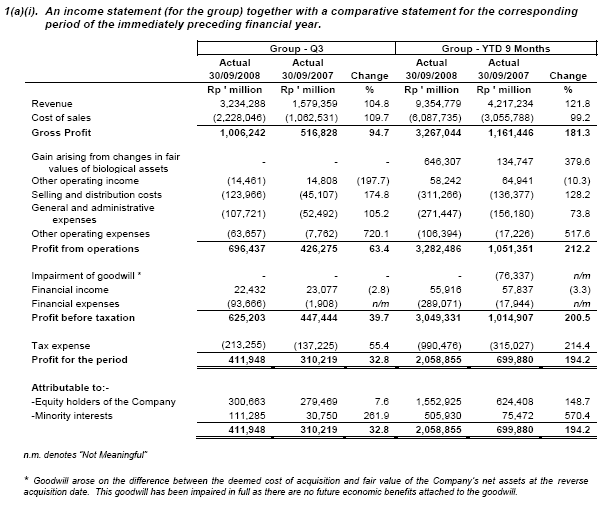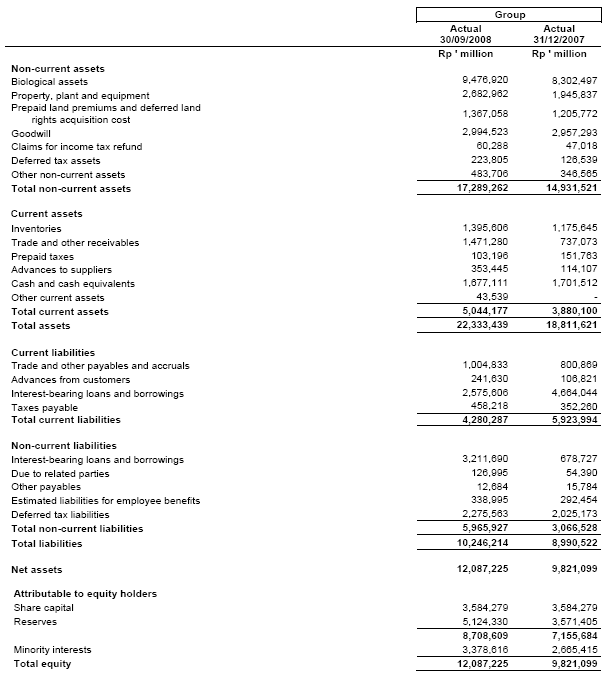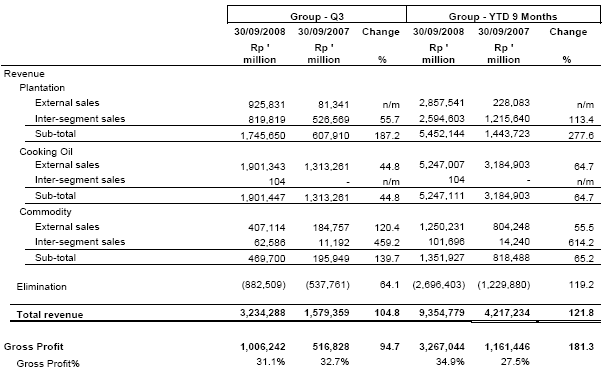Financial
UNAUDITED FINANCIAL STATEMENTS FOR THE THIRD QUARTER ENDED 30 SEPTEMBER 2008

Balance Sheet

Review Of Performance
Review of Group Performance

Revenue and Gross Margin: During Q3 2008, the Group posted revenue growth of 105% to Rp3.2 trillion. The key drivers for the said revenue growth were higher volume growth from all business divisions, higher selling prices of edible oil products and a positive contribution from Lonsum. On a year-to-date basis, revenue exceeded same period last year by 122%.
Overall gross profit margin for the quarter was marginally lower due mainly to the effect of the consolidation of Lonsum, given that Lonsum has a lower gross profit margin.
Plantation division continued to post positive revenue growth in Q3 2008. Revenue was up 187% to Rp1.7 trillion driven largely by the additional contribution of Rp964 billion from Lonsum and higher volume growth. CPO volume increased from 82,692 MT in Q3 2007 to 186,784 MT during the quarter, which was largely driven by the additional volume contribution from Lonsum. On year-to-date basis, revenue rose by 278% to Rp5.5 trillion compared to the results of the comparative period last year.
Cooking oil and fats division likewise recorded a positive result in Q3, with revenue growth by 45% to Rp1.9 trillion. The improved revenue was driven largely by higher selling prices and volume growth in consumer pack cooking oil in the domestic Indonesian market. On year-to-date basis, this division enjoyed a revenue growth of 65% and improved gross profit margins from higher selling prices and volume growth.
Commodities division posted revenue growth of 140% and 65% in Q3 2008 and year-to-date respectively due to higher export volume of crude coconut oil and average selling price.
Gain arising from changes in fair values of biological assets: It is the intention of the Group to engage an independent valuer to perform the biological assets valuation on half-yearly basis. Accordingly, there was no change of the value of the biological assets in Q3 2008.
Biological assets comprise primarily oil palm and rubber plantations. The fair values of biological assets are determined using the discounted future cash flows of the underlying plantations. The expected future cash flows of the underlying plantations are determined using the forecasted market prices of the related agricultural produce.
Profit from Operations rose by 63% to Rp696 billion during the quarter and up by 212% to Rp3.3 trillion on year-to-date basis. The improved profit during the quarter was largely driven by the foregoing factors. These profits were achieved despite (i) increased selling and distribution costs arising mainly from higher freight cost and Indonesia export tax rate; (ii) higher G&A expenses arising from the inclusion of newly acquired subsidiaries, and higher salaries and wages attributed mainly to salary rate increment; and (iii) lower operating income attributed to net foreign exchange loss of Rp27 billion relating to the revaluation of US$ denominated loans and higher operating expenses from loss on decline in values of inventory of Rp65 billion.
Net Profit After Tax for the quarter and year-to-date increased by 33% and 194% to Rp411 billion and Rp2.1 trillion respectively. The Group achieved these notable profits notwithstanding higher interest expenses relating to the loans obtained to fund the acquisition of Lonsum.
Review of Financial Position
Biological assets increased from Rp8.3 trillion in Dec 2007 to Rp9.5 trillion primarily due to additional planting cost of oil palm and gain arising from the changes in fair value of biological assets recognized in Q2 2008.
Property, plant and equipment increased from Rp1.9 trillion in Dec 2007 to Rp2.7 trillion due to purchase of equipment, construction of housing and infrastructure in plantations, as well as the consolidation of a new subsidiary, LPI in Q3 2008. Similarly, the increase in prepaid land premiums and deferred land right costs was largely relating to LPI.
The increase in current assets was attributed largely to (i) higher inventory of CPO, by-products and fertilizers, (ii) increase in trade receivables and other receivables on higher sales of edible oil products and receivables from futures commodity contracts, (iii) higher advance to suppliers for purchase of goods, equipment and services.
Trade and other payables and accruals rose by Rp203 billion to Rp1.0 trillion on higher purchases of fertilizers and payables from futures commodity contracts.
Non-current interest bearing loans and borrowings increased from Rp678 billion in Dec 2007 to Rp3.2 trillion in Sep 2008 primarily due to the refinancing of US$160 million and Rp1.0 trillion of 1-year bridging loan facilities to 5-year term loan in the second quarter 2008. The net decrease in short-term loans and borrowing was because of the aforesaid refinancing exercise.
The estimated liabilities for employee benefits moved up from Rp292 billion in Dec 2007 to Rp339 billion in Sep 2008 due to additional provision in compliance with the Indonesian labor law. The higher deferred tax liabilities were in line with the gain arising from changes in the fair value of the biological assets.
Commentary On Current Year Prospects
The sharp global economic downturn, led by the US financial crisis has been on an unprecedented scale. The turbulence in the financial markets has spilled over to commodity markets, and together with the steep decline in petroleum prices has led to a steep downward fall in CPO prices given the recent correlation between the prices of these two commodities.
Given the uncertainty over the full extent of the financial crisis, it is too early to predict the full effects on the global economy in the next 12 months. However it is likely that CPO prices will remain soft in the next 12 months.
Nonetheless, the outlook for palm oil demand remains positive given that currently i) more than 85% of CPO is consumed as food, with increasing demand from China and India ii) approximately 10% is used for oleo-chemical use and iii) bio-diesel demand remains low at approximately 5%, but has the potential to grow given that CPO is a cheaper feedstock than competing vegetable oils.
On the other hand, the retreating petroleum prices should help ease the inflationary pressure on freight and transportation costs and fertilizers.
The Group will continue to focus on optimizing production efficiency, and increasing sales of edible oil products. Together with its integrated agribusiness model, the Group is well positioned to face the challenges ahead.